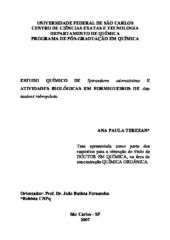| dc.contributor.author | Terezan, Ana Paula | |
| dc.date.accessioned | 2016-06-02T20:34:08Z | |
| dc.date.available | 2008-08-21 | |
| dc.date.available | 2016-06-02T20:34:08Z | |
| dc.date.issued | 2007-04-25 | |
| dc.identifier.citation | TEREZAN, Ana Paula. Phytochemical study of Spiranthera odoratissima and biological activity in ants nest of Atta sexdens rubropilosa. 2007. 167 f. Tese (Doutorado em Ciências Exatas e da Terra) - Universidade Federal de São Carlos, São Carlos, 2007. | por |
| dc.identifier.uri | https://repositorio.ufscar.br/handle/ufscar/6096 | |
| dc.description.abstract | This work describes the biossay-guided the phytochemical study of Spiranthera odoratissima (RUTACEAE), with test against the symbiotic fungus Leucoagaricus gongylophorus, leaf-cutting ant Atta sexdens rubropilosa and pectinases enzymes of the faecal fluid of leaf-cutting ant. The phytochemical study of actives extracts allowed the identification of 15 substances: lupeol, lupenone, sitosterol, estigmasterol, campesterol, dictamine, ã-fagarine, esquimianine, 4,8-dimetoxyfuro[2,3-B]quinoline-5-7-diol, 1-methyl-2-phenyl-4- quinolone, 1-methyl-8-methoxy-2-phenyl-quinolin-4-one, limonine, limonexic acid, iso-limonexic acid e 23-hidroxy-21-oxo-dihydroodoratine. The compounds 1-methyl-8-methoxy-2-phenyl-quinolin-4-one, iso-limonexic acid e 23-hidroxy- 21-oxo-dihydroodoratine are described for the first time in the literature. 4,8- Dimetoxyfuro[2,3-B]quinoline-5-7-diol, 1-methyl-2-phenyl-4-quinolone, limonine and limonexic acid were isolated for first time from the Spiranthera genus. The branch extracts of the S. odoratissima were active against the L. gongylophorus fungus , inhibiting 100% of its growth and showed insecticide activity against leaf-cutting ants in survival biossay, with significant reduction leaf-cutting ants lifetime (5,5 days) when compared with the control group (25 days). The antimicrobial tests showed low activity of S. odoratissima against the The flavone biotransformation studies carried out with the symbiotic fungus L. gongylophorus on YNB liquid medium, solid medium and on the ants nest of the A. sexdens rubropilosa showed degradation of flavone. This degradation probably is done by the enzymatic system of the symbiotic fungus L. gongylophorus and others microorganisms presents on waste of ants nest. | eng |
| dc.description.sponsorship | Universidade Federal de Sao Carlos | |
| dc.format | application/pdf | por |
| dc.language | por | por |
| dc.publisher | Universidade Federal de São Carlos | por |
| dc.rights | Acesso Aberto | por |
| dc.subject | Atividade inseticida | por |
| dc.subject | Spiranthera odoratissima | por |
| dc.subject | Atta sexdens rubropilosa | por |
| dc.subject | Leucoagaricus gongylophorus | por |
| dc.title | Estudo químico de Spiranthera odoratissima e atividades biológicas em formigueiros de Atta sexdens rubropilosa | por |
| dc.title.alternative | Phytochemical study of Spiranthera odoratissima and biological activity in ants nest of Atta sexdens rubropilosa | eng |
| dc.type | Tese | por |
| dc.contributor.advisor1 | Fernandes, João Batista | |
| dc.contributor.advisor1Lattes | http://genos.cnpq.br:12010/dwlattes/owa/prc_imp_cv_int?f_cod=K4787151T1 | por |
| dc.description.resumo | Esta tese apresenta o estudo fitoquímico da planta Spiranthera odoratissima (RUTACEAE), biomonitorado por ensaios biológicos com o fungo simbionte Leucoagaricus gongylophorus, a formiga cortadeira Atta sexdens rubropilosa e as enzimas pectinases do fluido fecal da formiga cortadeira. O estudo fitoquímico dos extratos ativos levou a identificação de 15 substâncias: lupeol, lupenona, sitosterol, estigmasterol, campesterol, dictamina, ã-fagarina, esquimianina, 4,8-dimetoxifuro[2,3-B]quinolina-5-7-diol, 2-fenil-1-metilquinolin- 4-ona, 2-fenil-1-metil-8-metoxi-quinolin-4-ona, limonina, ácido limonéxico, ácido iso-limonéxico e 23-hidroxi-21-oxo-diidroodoratina. Sendo 2- fenil-1-metil-8-metoxi-quinolin-4-ona, ácido iso-limonéxico e 23-hidroxi-21- oxo-diidroodoratina inéditas na literatura e 4,8-dimetoxifuro[2,3-B]quinolina-5- 7-diol, 2-fenil-1-metil-quinolin-4-ona, limonina e ácido limonéxico isoladas pela primeira vez no gênero Spiranthera. Os extratos dos galhos da planta S. odoratissima apresentaram 100% de inibição no desenvolvimento do fungo simbionte L. gongylophorus e ação sobre a sobrevivência média de 5,5 dias em um experimento de 25 dias com as formigas cortadeiras Atta sexdens rubropilosa. Os ensaios antimicrobianos mostraram a baixa potencialidade da planta S. odoratissima contra os microrganismos testados. Os estudos de biotransformação da flavona realizados com o fungo simbionte L. gongylophorus nos meios líquidos YNB, meio sólido e no formigueiro de A. sexdens rubropilosa mostraram a possível degradação da flavona pelos sistemas enzimáticos do fungo simbionte L. gongylophorus e de outros microorganismos presentes no lixo do formigueiro. | por |
| dc.publisher.country | BR | por |
| dc.publisher.initials | UFSCar | por |
| dc.publisher.program | Programa de Pós-Graduação em Química - PPGQ | por |
| dc.subject.cnpq | CIENCIAS EXATAS E DA TERRA::QUIMICA | por |
| dc.contributor.authorlattes | http://lattes.cnpq.br/2664450414569031 | por |
